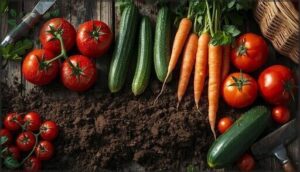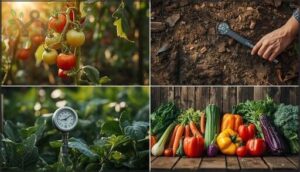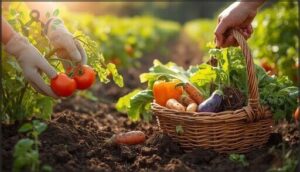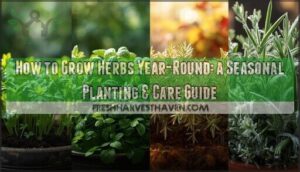This site is supported by our readers. We may earn a commission, at no cost to you, if you purchase through links.

Knowing when to harvest garden vegetables isn’t just about watching the calendar; it’s about reading the subtle signals each crop sends when it hits that perfect sweet spot. Color shifts, firmness tests, size checkpoints—these clues tell you exactly when your vegetables have peaked and won’t get any better on the vine.
Once you learn to spot these signs and understand what affects ripening in your specific garden, you’ll start bringing in vegetables at their absolute best, transforming your meals with flavors store-bought produce can’t touch.
Table Of Contents
- Key Takeaways
- Key Signs Your Vegetables Are Ready to Harvest
- Factors That Impact Vegetable Harvest Timing
- Step-by-Step Harvesting Techniques for Your Garden
- Post-Harvest Care and Vegetable Storage Tips
- Top 3 Harvest Baskets and Tubs for Gardeners
- Frequently Asked Questions (FAQs)
- When should vegetables be harvested?
- When should you pick fruits & vegetables?
- How often do you harvest vegetables?
- How do you harvest vegetables?
- What vegetables can you harvest in fall?
- How do you pick a vegetable if it’s not ready to pick?
- How do I know when my veggies are ready to pick?
- Should you till your vegetable garden in the fall?
- What is the harvest time for vegetables?
- How to keep garden veggies fresh all winter?
- Conclusion
Key Takeaways
- You’ll know your vegetables are harvest-ready when you spot clear signals like color changes (tomatoes at 90% red, melons showing yellow ground spots), proper firmness when gently squeezed, and size markers specific to each crop—combining touch, smell, and sight boosts your timing accuracy to 87.5%.
- Harvest timing varies wildly by crop and conditions, with zucchini ready in just 35-50 days while potatoes need up to 130 days, and factors like temperature extremes (above 94°F or below 55°F), soil quality, sunlight hours, and your growing zone’s season length all speed up or slow down when vegetables actually reach peak ripeness.
- Different vegetables demand different harvesting techniques—leafy greens need cool morning picking with a cut-and-come-again method, root crops require checking for peeking shoulders and using forks to lift gently, and fruit vegetables like tomatoes rely on color progression and easy stem detachment to signal readiness.
- Post-harvest care makes or breaks your crop’s longevity, so cool vegetables quickly after picking, handle them gently to prevent bruising, match storage methods to each vegetable type (refrigeration for greens, curing for squash, root cellaring for carrots), and check stored produce weekly while maintaining proper temperature and humidity levels.
Key Signs Your Vegetables Are Ready to Harvest
Knowing when to harvest your vegetables can feel like guesswork at first, but your plants actually give you clear signals when they’re ready. You just need to know what to look for—from color changes and size markers to subtle shifts in texture and aroma.
Let’s walk through the key signs that tell you it’s time to pick.
Visual and Textural Ripeness Indicators
Your vegetables broadcast their readiness through visual cues and texture changes. Color development marks the most reliable sign—watch for that telltale shift from green to vibrant red in tomatoes or creamy yellow ground spots on melons. Firmness assessment matters too; gently squeeze to feel for ideal give.
Shape changes, like blocky, well-filled pepper shoulders, signal peak maturity alongside these physiological markers that reveal harvest-perfect produce. You can also use chemical methods for precise assessment.
Color and Size Guidelines for Common Vegetables
Once you’ve spotted those color shifts and firmness cues, you’ll want specifics. Tomatoes need 90% red coverage, while slicing cucumbers reach harvest readiness at 6 to 8 inches with dark green skin. Carrots show maturity indicators when orange shoulders peek through soil at ¾-inch diameter.
Grading standards and varietal differences matter—cherry tomatoes mature at just 1 to 1.5 inches, proving that ideal color and size indicators vary widely across your garden’s bounty. Harvesting at the correct time affects vegetable taste and quality.
How Touch and Smell Help Determine Maturity
Beyond what your eyes reveal, tactile indicators and aroma compounds offer powerful maturity clues. Firmness tells you when melons and tomatoes hit peak ripeness, while a sweet, earthy scent signals carrots are ready.
Sensory integration—combining touch, smell, and taste—boosts vegetable maturity accuracy to 87.5%, helping you time harvest perfectly. These biochemical changes in texture and flavor are nature’s ripeness scales at work.
Combining touch, smell, and taste boosts harvest timing accuracy to 87.5%, turning your senses into nature’s ripeness meter
Differences in Harvest Timing for Various Crops
Now that you’ve gauged ripeness with touch and smell, harvest timing differs widely depending on which vegetables you grow. Crop maturity rates span a vast range:
- Zucchini reaches harvest in just 35 to 50 days from planting
- Lettuce matures between 40 and 50 days, offering quick seasonal harvest windows
- Carrots need 85 to 95 days before pulling
- Potatoes may require up to 130 days
Environmental impact and physiological factors shape when to harvest each variety.
Factors That Impact Vegetable Harvest Timing
You might plant everything perfectly, but harvest timing isn’t just about watching the calendar. Weather shifts, soil health, sunlight hours, and even the variety you chose all play a role in when your vegetables are truly ready.
Let’s look at the key factors that determine whether you’re picking too early, too late, or right on time.
Effects of Climate and Weather on Ripeness
Think of weather as your garden’s invisible clock—it speeds up or slows down ripening more than you might realize. Temperature extremes above 94°F shut down photosynthesis and halt ripening, while frost impact below 55°F can damage tender crops overnight.
Humidity effects, rainfall patterns, and seasonal variations all create yield fluctuations, making climate the master switch for your harvest timing. These weather conditions demand constant attention.
Influence of Soil, Water, and Sunlight
Your soil quality, sunlight exposure, and watering habits shape harvest timing just as much as the weather conditions outside your control. Nutrient-rich soil fertility accelerates maturity by 10-20%, while consistent moisture boosts root yields by up to 90%.
Leafy greens need 3-4 hours of sun, but fruiting crops demand 7-8 hours to maintain photosynthesis rate. Soil temperature between 50-85°F prevents water stress and promotes plant health.
Role of Plant Variety and Maturity Rates
Variety selection matters more than most gardeners realize. Early Girl tomatoes reach harvest in just 50 days, while Beefsteak needs 96—a six-week difference. Pink Banana squash takes 120 days compared to acorn squash at 80.
These maturity genetics determine your harvest windows and yield outcomes. Check seed packets for “days to maturity” and choose varieties that match your growing season, not just your taste preferences.
Seasonal Variations and Their Harvest Implications
Your harvest season shifts dramatically with your zip code. The Southeast enjoys 229-day growing seasons, while Northeast gardeners work with just 90 days—altering everything from planting season strategies to fall vegetable harvesting windows.
Regional growing seasons create three distinct patterns:
- Spring plantings yield June-July harvests in middle Georgia
- Fall vegetable harvesting peaks October through December in warmer zones
- Weather extremes impact timing by 2–3 weeks annually across frost zones
Climate harvest timing determines whether you’ll bite into sweet summer corn or store winter squash. Seasonal variations in taste intensify during peak harvest fall periods when vegetables mature under ideal conditions. Understanding these patterns helps you get the most from both yield and flavor.
Step-by-Step Harvesting Techniques for Your Garden
Knowing when to harvest is only half the battle—you also need to know how to do it without damaging your precious crops. Different vegetables require different techniques, from the gentle touch needed for leafy greens to the careful digging required for root crops.
Let’s walk through the best methods for harvesting each type of vegetable in your garden.
Harvesting Leafy Greens for Maximum Freshness
Leafy greens reward you with peak flavor when harvested during cool morning hours, before heat wilts their crisp texture. Look for harvest indicators like rich color and firm leaves—these tell you freshness is at its best.
Use the cut-and-come-again method by snipping outer leaves while letting inner ones grow, extending your harvest for weeks. Quick cooling after picking maintains best harvest quality and vegetable freshness under proper storage conditions.
Picking Root Vegetables at Peak Quality
When orange carrot tops peek through the dirt, your root vegetables are sending a harvest signal. Root crop harvesting depends on ideal size—aim for carrots at 1.5–2.5 cm diameter, beets at 2–3 inches.
Check soil moisture before digging; drier ground prevents damage. Frost impact actually sweetens parsnips and carrots, so wait for cool weather.
Use harvesting tools like forks to lift roots gently, preserving storage duration and vegetable maturity.
Collecting Fruit Vegetables Like Tomatoes and Peppers
Unlike root crops, fruit vegetables like tomatoes and peppers rely on ripeness indicators you can see and feel. Tomatoes progress through color stages from green to pink (30-60% red) to full red, usually 73-75 days after planting. Peppers shift from green to their mature hue—red, yellow, or orange—in 2-4 weeks.
Use tactile cues: ripe fruit feels slightly soft but firm and detaches easily, signaling harvest windows that match your storage needs.
Continuous Vs. One-Time Harvesting Practices
Your crop quality and yield patterns hinge on whether you’re working with continuous or one-time harvest vegetables. Continuous vegetable harvesting—like zucchini, cucumbers, and peppers—demands frequent picking throughout the season to maintain ideal harvest time and flavor.
One-time crops like determinate tomatoes and bush beans consolidate their harvest windows into brief bursts, simplifying labor management and freeing garden space for succession planting.
Proper Use and Maintenance of Harvesting Tools
Your harvesting tools deserve the same care you give your plants. Clean blades after every use to prevent disease spread—removing debris cuts contamination by 90%. Sharpen cutting tools every 3-5 harvests for safer, more efficient work. Here’s how to extend your tools’ lifespan:
- Rinse and dry immediately after hand harvesting methods to avoid rust
- Store on racks in dry spots, not on damp ground
- Oil wooden grips twice yearly
- Check for loose parts before each use
- Keep specialized care routines for pruners and sickles
Regular inspection catches problems early, saving you money and frustration.
Post-Harvest Care and Vegetable Storage Tips
Getting your vegetables out of the garden is only half the battle—what you do next determines how long they stay fresh and flavorful. Proper handling, smart storage choices, and a few preservation tricks can stretch your harvest for weeks or even months.
Let’s walk through the essential steps to keep your hard-earned vegetables in peak condition.
Cleaning and Handling to Prevent Damage
After harvesting vegetables, your first job is protecting what you just grew. Initial cleaning removes field debris, while gentle handling prevents bruising that invites decay. Tool sanitation cuts contamination risk by over 90%, and proper temperature control immediately after harvest locks in freshness.
Here’s your postharvest care checklist:
| Postharvest Care Step | Why It Matters |
|---|---|
| Remove field dirt gently | Prevents surface damage and microbial growth |
| Sanitize knives and containers | Reduces bacteria transfer by 90% or more |
| Cool produce quickly | Slows respiration and preserves quality |
| Handle with care | Prevents bruising that accelerates spoilage |
| Control moisture levels | Stops decay and extends shelf life |
These harvesting techniques set the stage for everything that follows.
Short-Term Vs. Long-Term Storage Methods
When you match storage methods to the vegetable type and how long you want it to last, you protect your harvest timing work. Short-term preservation generally spans days to weeks using simple refrigeration, while long-term storage reaches several months through specialized techniques.
Here’s your storage approach breakdown:
- Refrigeration: Best for leafy greens, extends freshness days to weeks by controlling humidity levels
- Curing and drying: Ideal for onions, garlic, and winter squash needing months of preservation
- Cold storage: Maintains carrots, beets, and potatoes for months at 32-40°F with proper atmosphere technology
- Freezing: Top vegetable preservation choice for peas, beans, and corn
- Root cellaring: Traditional vegetable storage methods requiring consistent cool, humid conditions
Techniques for Preserving Excess Harvest
Turning abundance into year-round bounty takes the right preservation approach. Freezing methods work best at 0°F, locking in nutrients for 8-12 months. Canning safety demands precise temps—240°F for low-acid veggies prevents spoilage. Dehydration temps of 125-140°F create shelf-stable options.
Fermentation duration spans one to eight weeks, building flavor and probiotics. Root cellaring suits hardy crops like carrots and potatoes, extending your post-harvest care and storage success.
Monitoring and Maintaining Stored Vegetables
Beyond preservation methods, your longterm storage success hinges on vigilant care. Check store vegetables weekly for spoilage indicators like soft spots or off smells. Temperature control near 32°F and humidity levels between 85-95% prevent shriveling. Hygiene practices matter—remove damaged produce immediately to stop contamination.
Storage duration varies: carrots last 16-20 weeks under proper storage conditions, while leafy greens fade within three weeks.
Top 3 Harvest Baskets and Tubs for Gardeners
Once you’ve harvested your vegetables, you’ll need a sturdy container to carry them from garden to kitchen. The right basket or tub makes collection easier and helps protect your produce from bumps and bruises.
Here are three reliable options that gardeners actually use and recommend.
1. Cornucopia Brands Natural Wooden Baskets
If you’re looking for a harvest basket that balances aesthetic appeal with practical function, these wooden beauties might be just the ticket. Each 4-quart basket holds about 8 inches of fresh vegetables when it’s time to harvest your garden.
Market pricing runs $15-$25 for a 2-pack, which customers rate highly for harvest capacity and basket durability. They’re perfect for picking tomatoes, beans, and leafy greens at the best harvest timing.
Just note they work best for small to medium hauls, not bushels of winter squash.
2. United Solutions Red Round Storage Tub
When you’re harvesting vegetables in bulk, you’ll want something tougher than a basket. This 19-gallon tub features heavy-weight polypropylene construction and reinforced rope handles that won’t quit when you’re lugging squash or potatoes from the garden.
The round shape benefits stacking, and the tub material withstands weather without cracking.
Customers love its versatility uses—from harvest timing runs to storage design for winter crops. At around $15-20, it’s a workhorse for serious vegetable harvesting. Just don’t stand on it in cold weather.
3. Behrens 5 Gallon Galvanized Steel Tub
If you’re serious about sustainable gardening, this 5-gallon steel tub outlasts plastic by years. Its galvanized steel uses span everything from harvesting vegetables at peak harvest time to garden storage uses that protect your crop through winter.
The material safety checks out for edible plants, and steel tub durability means it won’t crack when you’re hauling root vegetables from cold soil.
At 14.6 inches wide and watertight, it doubles as a wash station during harvest time. Around $15-20, it’s the last harvest container you’ll buy.
Frequently Asked Questions (FAQs)
When should vegetables be harvested?
You’ll taste the difference when vegetables reach peak ripeness—that sweet spot where peak flavor meets perfect texture.
Harvest indicators like color, firmness, and size reveal maturity stages, making harvest time decisions surprisingly straightforward once you know what to watch for.
When should you pick fruits & vegetables?
You should pick fruits and vegetables at peak ripeness for the best flavor and texture.
Look for visual signs, proper maturity indicators, and best timing based on each crop’s specific harvesting factors.
How often do you harvest vegetables?
Some crops are like a daily gift, ready every 2–3 days, while others follow staggered sowing rhythms.
Harvest frequency depends on variety and climate impact—succession planting keeps your basket full all season long.
How do you harvest vegetables?
Use sharp scissors or pruning shears for harvesting vegetables. Cut stems cleanly to minimize damage and disease entry. Handle produce gently to prevent bruising. These harvesting techniques preserve quality and encourage continued production.
What vegetables can you harvest in fall?
Fall brings a wonderful selection of vegetables to your garden. You can harvest root crops like carrots, beets, turnips, and radishes, plus leafy greens including kale, spinach, and lettuce—all benefiting from cooler temperatures.
How do you pick a vegetable if it’s not ready to pick?
You can’t pick vegetables that aren’t ready—they lack proper maturity, flavor, and texture. Instead, monitor ripeness indicators closely and use staggered harvest timing.
Partial picking methods work for some leafy crops, though immature harvesting risks poor vegetable quality.
How do I know when my veggies are ready to pick?
Your garden speaks in sensory ripeness cues—firmness, aroma indicators, and visual cues reveal maturity.
Touch vegetables for ideal texture, inhale for fragrance, and observe color shifts.
These signs guide you to the perfect, best harvest moment.
Should you till your vegetable garden in the fall?
Tilling your vegetable garden in fall often increases weed pressure and nutrient loss while disrupting soil health. Instead, consider leaving it untilled to protect beneficial organisms, reduce erosion, and preserve soil structure for better garden care.
What is the harvest time for vegetables?
Harvest time depends on ripening stages, visual harvest indicators, and peak flavor moments.
Most vegetables reach best harvest time when color deepens, size is right, and texture feels firm—signs of vegetable maturity stages that guarantee quality.
How to keep garden veggies fresh all winter?
You’ll want proper curing methods and humidity control to extend storage. Root vegetables need cold, moist conditions, while onions prefer cool, dry spots.
Freezing veggies and canning options preserve surplus harvests beautifully for long-term vegetable storage.
Conclusion
Nailing the perfect harvest moment transforms your entire gardening experience from guessing game to confident craft. You’ve learned when to harvest garden vegetables by reading their unique signals—color shifts, firmness tests, size checkpoints—and understanding how your climate and care routines influence timing.
Now you’re equipped to bring crops in at their absolute peak, when flavors explode and textures satisfy. Those subtle cues you once overlooked? They’re your roadmap to harvests that’ll make every meal unforgettable.
- https://www.facebook.com/groups/homesteadingforbeginners/posts/2337387606458610/
- https://www.thrivelot.com/resources/how-harvest-timing-impacts-garden-yield-and-flavor
- https://piedmontmastergardeners.org/article/guidelines-for-harvesting-vegetables/
- https://www.walshmedicalmedia.com/open-access/assessment-of-harvesting-time-and-its-influence-on-yield-production-in-agricultural-crops-127121.html
- https://pmc.ncbi.nlm.nih.gov/articles/PMC11941550/










